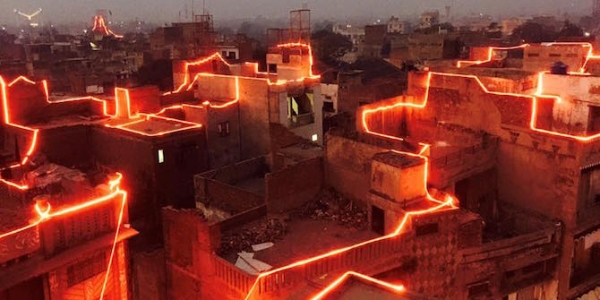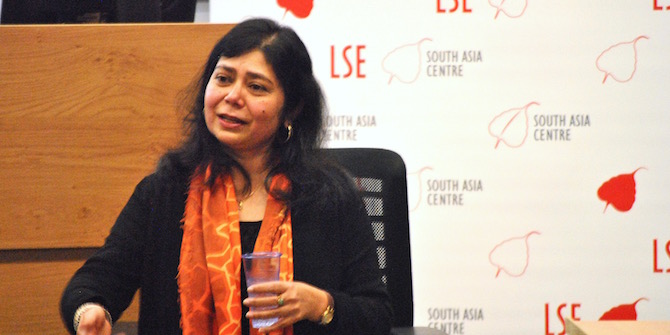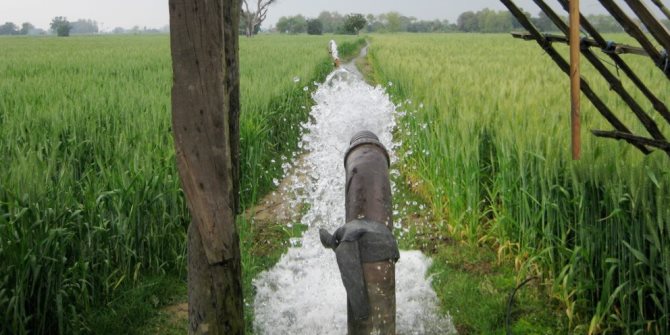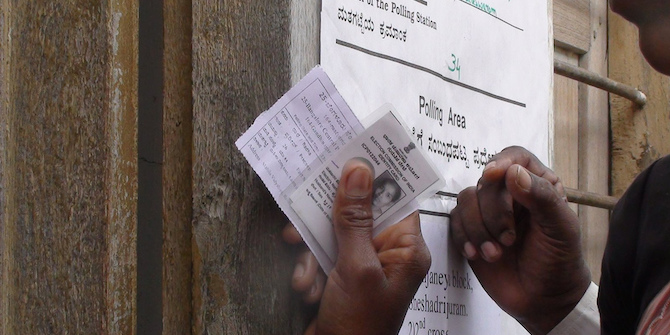 In April, Pakistani academic and artist Farida Batool spoke on the Art and Modernity panel at the LSE Pakistan Summit 2017. Afterwards, Sonali Campion interviewed her about her work with the Awami Art Collective, a group which protests, reclaims public space and builds community using art.
In April, Pakistani academic and artist Farida Batool spoke on the Art and Modernity panel at the LSE Pakistan Summit 2017. Afterwards, Sonali Campion interviewed her about her work with the Awami Art Collective, a group which protests, reclaims public space and builds community using art.
SC: You co-founded the Awami Art Collective, a group of artists and activists which has done a number of installations in public spaces in Lahore. What are your aims?
FB: In our projects the goal is to create a relationship with people at mass level, and to start a dialogue about issues which affect all of us. People in Pakistan often feel whatever is happening around them – whether it is development, heritage issues, political issues etc. – that as long as it is not affecting them that they do not have to engage. So we try to bring everyone to one platform through creative forces and show that it is ‘us’ as a community who are being affected.
In what ways have you done that?
We applied this in multiple ways, according to the need of the project. In Hum jo Tareek Rahon Mein Marey Gai (We who were slain in dark alleys), which addressed political violence in Pakistan, we created a path under bunting made with news clippings. Each triangle was a record of an event, offering a simple fact sheet indicating who was murdered and why. It might have been in the name of blasphemy, or because the person was from another sect, or other political reasons, for example the polio workers working in the FATA region who were attacked by the Taliban. We created this 30-year history documenting the violent attacks on people in different parts of Pakistan, and made people walk under it, like a walk down a memory lane. We wanted them to stop, think, reflect and feel the events and remember what exactly had happened. It aimed to create an ephemeral understanding, rather than giving concrete answers critiquing specific policies.
In our second project the idea was totally different – it was a celebration in protest of the scrapping of a festival. The Basant kite festival was banned in Lahore, they used to have festivities and everyone would come to the walled city with their families. They would climb on the rooftops and participate in a festival that was secular in nature, with lots of music and food. It brought together all sections of society, be it rich or poor, in one area.
That has now gone, so we tried to create the memory in a celebratory way, which was the opposite of what happened in the other project. People were asked to come on to their rooftops and experience the installation of light, and there was music, performance and street food – the community was very willing to participate. This installation was about triggering a memory associated with something the community had lost, and reminding them “let’s do something about it together”. The media picked up the story again, there were attempts by the government to create a committee to see what are the ways we can have a safe kite festival, although this never happened. But we created a memory. These are the strategies we used.

What kind of creative processes are involved in making those installations happen? How easy is it to access the spaces that you need for artistic protest?
The Awami Art Collective is not just an artists’ group. Some of us are artists, some are activists, some are academics and media people. We have meetings about what we want to do, and for a long time. It is a very contested space but it helps in our creative process. Those who are more critical pose questions to the creative artists, asking how this idea is going to make sense. Artists usually just think of themselves in their creative expression, but these people in our group helped us to think about whether we are really communicating through our expression. This is how these projects come about.
We were very surprised to see how well people received the Basant project in particular because it was very conceptual. But when we approached people at Taxali gate in the walled city they understood it very quickly. They could see the colour and the string, and they said, “Oh we understand what you want to do, and you are also questioning metro train, development which is changing our heritage”. We said, “yes, how do you know this?” They responded, “It’s obvious, and we are with you!”
In terms of accessing the spaces, we had to get permission from the government to use the garden for the political violence work because it was their space. In that case we were able to use the timing, it was just after the Army Public School incident where the Taliban killed 40 students and the government’s perspective changed. They knew they needed to take serious action against terrorism, so they were more willing to listen even though there hadn’t been space for us previously. We said, “Listen, we want to talk about terrorism. Can you give us permission to use this public garden?” They never came to see our project but they gave us the space, the infrastructure, and some money which partially helped us to print the bunting. I felt, and we all agreed in the Collective that this was a political strategy. It is the government and their successive policies which have fostered this violence, so they should pay for it.
For the other project we knew that we would not be given permission. They are the ones who banned the festival and are adamant about having the metro running through the heritage sites. So how did we go about it? It is public, yet not public space. So we went to individual houses and asked people if we could use their rooftops.
And in doing so you are actually building community?
Yes, and the healing part was that people were so trusting. It was not only a question of permission, those giving the permission were also taking responsibility for paying the electricity bill. We said it has to be participatory, and they agreed to it. Sometimes we would be designing the installation on a rooftop and discussing where the light should go. There would be a discussion of “let’s take this over there”. These are five, seven storey houses, who has the energy to spend all day going up and down? So we would climb across and someone would come out and say “what are you doing on my rooftop?” and we would explain and ask, “do you mind if we use your space?” They would take a second then say, “OK, just go ahead”. People trusted us, that one month installation period was the most therapeutic aspect of the project. Interacting with the community and getting access to these spaces was like a bonding experience.
Watch the Pakistan @ 70 Art and Modernity panel in full here. You can also see a short video with Farida Batool talking about art in the public domain here.
This article gives the views of the interviewee, and not the position of the South Asia @ LSE blog, nor of the London School of Economics. Please read our comments policy before posting.
About the Authors
 Dr Farida Batool is an independent artist who explores Pakistan’s political upheavals and tumultuous history. She frequently showcases her work at international art galleries around the world. Farida received her PhD from the Centre for Media Studies at The School of Oriental and African Studies, London.
Dr Farida Batool is an independent artist who explores Pakistan’s political upheavals and tumultuous history. She frequently showcases her work at international art galleries around the world. Farida received her PhD from the Centre for Media Studies at The School of Oriental and African Studies, London.
 Sonali Campion is Communications and Events Officer at the South Asia Centre. She holds a BA (Hons) in History from the University of Oxford and an MSc in Comparative Politics from LSE. She tweets @sonalijcampion.
Sonali Campion is Communications and Events Officer at the South Asia Centre. She holds a BA (Hons) in History from the University of Oxford and an MSc in Comparative Politics from LSE. She tweets @sonalijcampion.








Great work by Farida Batool. Well done.
Muhammad Naeem ul Fateh